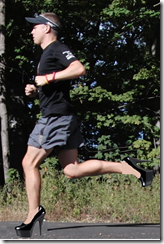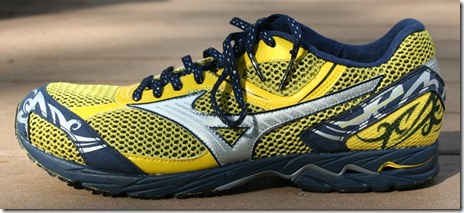 I have a confession to make. I ran in heels. I did it on purpose. And it worked (I think).
I have a confession to make. I ran in heels. I did it on purpose. And it worked (I think).
I’ve written a few times in the past week about how I strained something in my foot during the Manchester City Marathon. It had sidelined me for 5 days, and then flared up again on Saturday during my first run back. Through a combination of me knowing a thing or two about anatomy and a little Google medical sleuthing, I determined that the problem seemed to be some inflammation in the peroeus longus tendon which extends under the outside of the ankle and then curls under the sole from about midfoot toward the big toe. I mentioned this in a post on Twitter, and someone responded that a similar thing had happened to them and that running in a shoe with a bit of heel lift had helped during recovery.
In thinking about the Twitter response, I realized that I should have thought of the idea myself. Recently I wrote a post on repetitive overuse injuries in runners, and made the point that one of the things I try to do to avoid injury is rotate among shoes of varying properties. If something is bothering me in a particular shoe, I shelve it for a bit and try something else. Often, this clears up the problem and allows me to keep on running.
Not being one to hold off on trying something out (especially if it would let me run, which I desperately wanted to do), I decided that I would do a short run today in a pair of Mizuno Wave Ronin’s that have been feeling a bit neglected. The Ronin is a nice looking shoe (and no, it’s not the one in the picture at the top of the post – a friend photoshopped that piece of work for me as a joke), and fits about as well as any shoe that I have (very wide in the forefoot). However, the Ronin has a 9mm heel lift, which is above my threshold if I want to avoid a heel strike. The vast majority of my runs in the past year have been in shoes with a 6mm lift or less, so this shoe is structurally a lot different than what I’m used to. Thus, my hope was that it would alter the stress application on my foot in a way that might allow me to run without pain.
I left the house tentatively, planning to cut the run short at the slightest twinge of discomfort. It never came. I picked up the pace, and the foot still felt good. I eventually got to the point where I was running a sub-6:00 pace for a bit (not smart, but couldn’t resist) and wound up completing the 2.5 mile run at an average pace of just over 7:00/mile. I’m still aware that there is something “off” in my left foot, but it never hurt during the run, and I couldn’t be happier. I have no plans of going back to “high-heeled” shoes, but at least on this day, the Ronin, which actually has a lower heel than most training shoes out there (9mm vs. 12mm for most), served me very well. I’ll probably split the next several runs between the Ronin and the Brooks Launch, and re-evaluate my foot condition before getting back into my more typical shoes.
So what’s the point of all of this? Well, I guess it’s that I don’t want to ever come off as being dogmatic or stubborn when it comes to choosing a running shoe on a given day. Sometimes a bit of heel can be a help rather than a hindrance, and if wearing a shoe that doesn’t fit my normal preference allows me to run when I might otherwise not be able to, then so be it. Ultimately, shoes are simply tools that help us (in most cases) to participate in the sport we love, and that’s really what’s most important, isn’t it?















I would have to say that if the foot issue is in fact the distal tendon of the peroneus longus, the first thing I would ask is what, perhaps, is it compensating for? That would, however, require watching your movement pattern because it also may not be compensation.
I have no idea if this is true, but I read somewhere that the tendon can get
irritated sometimes from running in a narrow shoe, especially of the lateral
portion of the foot extends beyond the sole a bit. The two times I have had
this issue have resulted from running long miles in relatively narrow shoes
– the Nike Lunaracer and the Saucony Grid Type A4. I don’t think it’s so
much compensation as it is just irritating it over two really intense, long
runs in a narrow shoe. I’m guessing, so hard to know for sure.
Pete
I wear minimal casual shoes and i noticed that it is more difficult to walk midfoot/forefoot than to run.
Heel-toe is the proper walking gait – not the same action as running.
Nice experiment Peter, and while a single run isn’t enough data to make a good conclusion, of course, your logic certainly makes sense. Plus, thanks for the mini-review of the Ronin’s, the next step in the Mizuno line I’m considering.
Greg,
For your progression, the Ronin would be a good choice for a next step.
There is so much that I like about the shoe, just wish that I could take
about half the height off the heel.
Pete
Your very lucky to have so many pairs of shoes.
great idea! will try that. nice pic of you in heels! LOL ;p
Hi Pete, well that pic of you in the high heels alone was entertainment enough to start the morning! To share a bit of my experience with you, I think that peroneal tendon is at the heart of the problems I have been dealing with since July. It took me until the end of August to accept that resting it was going to be necessary to let it heal (not saying YOU need to rest it-hopefully yours is just an irritation). I did read somewhere that lifting the affected heel helps, because it shortens the achilles and therefore relieves some of the pressure on the attachment area (and that’s where I exhaust my anatomical knowledge, especially when talking to an anatomy professor!). And I have noticed, when walking around in “street shoes” with a bit of a heel that I have often been more comfortable than I have been in flats. Do be very attentive to this and listen to your body — although my “injury journey” has taught me a lot about other things (yoga, swimming, some other fitness options), it has been maddening to be out of the sport and know that I may have to start back five minutes at a time. Here’s my blog about part of this journey: link to waytenmom.blogspot.com… Take care!
Thanks Paula – the origin of my high heels picture was actually
because another online friend with a similar issue said that hers
feels much better when she is wearing heels. Sounds similar to your
experience with street shoes. It kills to noy be able to run!
Pete
On Tuesday, November 16, 2010, Disqus
….sure your friend “photoshopped” that high heel pic…mmm hmmm…
; )
OK, come clean, Pete! What other clothes are you borrowing from your wife?! ;)
I have also found that wearing shoes with a heel lift helps alleviates the pain from my calcaneal spur (Achilles insertion). Makes even more sense for my injury… I’m still surprised I ran that 1/2 marathon two weeks ago.
BTW on Sunday I tried my Bikilas again. It was the first time in over a month. I made an easy 3 mile run in them! 9:00 minute miles, nothing special, but NO HEEL PAIN! From now on I’m definitely going to rotate between shoes with different heel lifts.
Great news Dan, glad things are looking up for the heel pain! As for my
wife, she wouldn’t be caught dead in high heels, so I can’t blame her for
that picture :)
Pete
Pete – interesting post – did your forefoot or heel strike in the Ronins?
I’m guessing mostly heel strike in the Ronin’s. That was my intent anyway,
so I let my body just do what the shoes wanted it to.
Pete
Pete, I can really relate to this post. A couple of months ago, I was experiencing some significant discomfort on the lateral side of my left foot. This mostly occurred when running longer distances on pavement in my Inov-8 f-lite 230s.
My Google searches led me to believe that this was either due to peroneal tendon issues or the lesser known lateral version of PF. I didn’t want to give up running. So, I picked up a pair of Ronins in order to offer more of a heel lift and extra cushioning in lieu of my f-lites. The discomfort went away. I still run on pavement in the f-lites, but not longer than 4 miles for now.
Anyway, the Ronin is a great training shoe, I think. The 9mm heel is definitely noticeable the first few times running. But, you’ll find that you can still maintain a mid-foot strike in them. I intend to write a review of them on my own blog. So, I’ll be curious to see if you have further impressions to share about these shoes. The wide toe box is great, isn’t it?
Pete, another interesting post, as usual. I also had a problem similar to yours in the past that cost me 2 weeks of training. I had never have the intention to go back to my Nike Vomero but now, at least, I may have some use for it someday in the future. It seems that shoe rotation is more important than previously imagined. I am also very happy alternating treadmill with the streets. I think it may have a similar effect. No pain so far, although increasing milleage. I am looking forward for your following experiences. Regards,
Sergio (Brazil)
I was really hoping this was a post about how you tried high heels…you know, for the “science.” I like your take on minimalism though – it’s something I’ve been talking about for awhile. Instead of being dogmatic about it, minimalism should really be used as a tool to accomplish certain things rather than some type of running ideology. Barefoot running or minimalist shoes can help you run with more efficient form, strengthen your feet and lower legs, and just make you feel better. But it’s not the right decision every day for most people. Cheers!
Operating on a similar principle 2 days ago, I ran 6.5 miles in my Brooks Adrenalines – trying to alleviate pain in my right achilles. The achilles didn’t hurt, but then my knees did. Today, a speed workout in my trusty Mach 11s (thanks for that original review, Pete!) in sloppy muddy melting-snow conditions went much better; knees didn’t hurt, but achilles does. Dammit. What’s a runner to do??
Yeah, sometimes runners just can’t win!